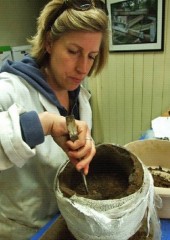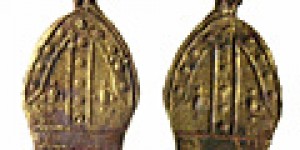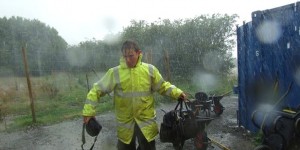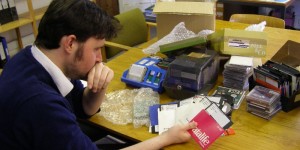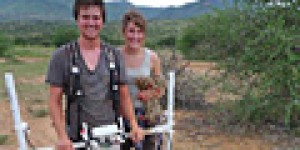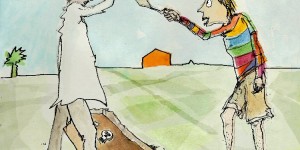Hilary Paterson is a PhD student at the University of York, specialising in artefacts and early medieval clothing accessories, who also works at the Yorkshire Museum. Post Hole Secretary Khadija McBain conducted this e-mail interview with her in May 2012.
Khadija McBain - Among the students at King's Manor, you are known as the 'artefacts girl', how did this come about?
Hilary Paterson - I did not know that! The main focus of my research is certainly artefacts based, but I suppose it is because I am usually raving about how much we can learn from studying artefacts. I have tried really hard to make artefacts the central focus of my teaching in the last few years, as there are comparatively few artefacts specialists in universities these days, and I would like my students to be enthused by the potential for material-based studies. I think that much of the attraction of artefacts, for archaeologists, is in the (very personal) tactile experience of handling them, which you will never get from pictures or reports. In putting artefacts back into classroom teaching, I think it allows students to appreciate the intrigue and exhilaration of getting up close to the things that were made, used and cherished by the people that we study. I really, really love artefacts!
KM - Can you tell us about your current PhD research? What do you enjoy most about it?
HP - For my PhD thesis I have been looking at dress and identity in early medieval Scotland and Ireland, and the ways in which the personal adornment items that make up the archaeological record of dress in these areas might have been used in sartorial communication and social discourse. My main aim was to think about the ways that they were used to symbolise status identities, and the impact that they (as material agents) might thus have had on the nature of hierarchical relationships in the past on both an individual and wider societal level. In attempting to do this I have been using a range of multidisciplinary sources, including the artefactual evidence of the dress items themselves, as well as historical documents and contemporary heroic literature. I really loved getting to grips with the Irish Cycle tales, which date from the 8th to 12th centuries in their written form, but might have been passed down through oral recitations for centuries before that. The characters of these tales are all really selfish and headstrong, and I doubt I would have liked any of them in real life, but I have really enjoyed reading about their adventures and costumes, and trying to relate these to the material record of early medieval Scotland and Ireland. In order to evaluate the role of dress and sartorial communication in the construction and maintenance of status identities, I also had to apply ideas from dress theory, used in anthropological studies of status relations in the workplace, amongst other things, and to try to reconcile these ideas with particular paradigms from archaeological theory, which I also loved, naturally. But the most enjoyable part of my research was definitely the opportunity to handle and examine some of the artefacts that I was studying.
KM - Why early medieval in northern Britain and Ireland?
HP - The pattern of deposition of dress items in northern Britain and Ireland makes the study of dress particularly difficult. Even before the adoption of Christianity, people in these areas did not bury their dead fully clothed or with grave-goods. This means that personal adornment items are never found within the context of dress assemblages, and that we cannot confidently ascribe particular types, styles or materials to different social groups in the early medieval period, as has been done with great success for Anglo-Saxon England. As a result, studies of dress accessories from northern Britain and Ireland have tended to focus on classification and discussions of the techniques used in their manufacture, rather than on identity or human relationships. I wanted to find a way of reassessing the wealth of evidence that we do have from these areas, to see if these issues could be overcome by way of a more holistic study and a different theoretical application, so that we could start thinking about the way that people used and understood dress in this period.
KM - What about the southerners?
HP - The social character of southern Scotland, England and Wales was very different to that of northern Scotland and Ireland, mostly as a result of the successive invasions of the Romans, Angles, Saxons and Jutes (and later Vikings and Normans). They differed not only in their hierarchical structure, urbanism and architecture, but also in their styles and use of dress items and their preference for burying with grave goods. As a result of this, and of a much more complete historical record, we know a lot more about dress and identity in these areas in the early medieval period, so that the necessity to re-evaluate the material evidence is not as strong. Importantly, though, these fundamental differences make England, in particular, unsuitable as a comparative area of study and would lead to difficulties in interpretation. But you are not missing out, by any means!
KM - Was dress and personal adornment as important in the medieval period as it is now?
HP - Yes, certainly, and perhaps even more so! My research deals with the use of dress to communicate aspects of personal and social identity to the people around you, which is based largely on modern anthropological studies. But in the early medieval period the statements made through the choice of dress items would have had much wider implications than simply demonstrating your knowledge of current trends. The colours and styles that people chose to wear would have allowed their peers, and strangers, to have identified and differentiated them in terms of age, gender, ethnicity, profession, status and lineage, which would have impacted upon their ability to gain access to certain regions, places, people and events. Making the right choices in personal appearance might have affected their potential to enter into marriage, friendship and certain professions. It would have determined their level of access to materials and craftsmen, and would ultimately have had some bearing on their potential for social mobility. In addition to this, the literary sources suggest that dress was the main way of differentiating friend from foe, and that this was hugely important in times of battle and conflict; uniform does not always seem to have been applicable to early medieval war-bands, and you certainly would not have wanted to be mistaken for the enemy!
KM - Was it only women involved in dressing to make a statement?
HP - Not at all. Most of the dress items that we find in early medieval Scotland and Ireland would have been worn by both males and females, and the literature certainly suggests that male vanity was a particularly sought after quality.
We do not see the same gendered differentiation in Celtic brooch types, for example, that have been identified in Anglo-Saxon graves, though we do believe that they would have been worn slightly differently by men and women. The statements that men and women made through their sartorial choices might have been very different, though; Jane Kershaw's work on Anglo-Scandinavian metalwork, for example, suggests that the dress accessories worn by women in the Danelaw were responsible for communicating information on ethnicity and cultural heritage in a way that men's accoutrements were not. There is certainly a lot of potential for us to reassess gender roles and identities in terms of the material agency of dress, and it is a topic that interests me greatly.
KM - What made you decide to do a PhD? Do you have any advice for students thinking about pursuing a PhD and how to go about the process? What options are next after completion of a PhD?
HP - A PhD is a massive undertaking, and a huge responsibility, both mentally and financially, so you have to really love the topic that you choose to research. I would advise any student interested in pursuing a PhD to speak to their supervisor about possible topics and funding options. There are a lot of funding bodies out there, tailored to suit a number of different groups, but there is also a lot of competition, so your research proposal is key. Some groups, such as the AHRC, will 'ring-fence' certain research areas (i.e. put money aside for projects set to answer specific questions), so you should see if you fit any of these criteria. Other, primarily private, institutes might seek to 'employ' a PhD researcher to study their history or collections, while a number of universities will offer funding for particular areas of research. I made the decision to fund my PhD independently, but it is very, very hard to fit your research around full time employment! Nonetheless, there are a number of options open to postdoctoral students, from teaching to site management and postdoctoral research. What you do next will depend entirely on what you choose to study, and where your particular strengths lie. I chose to pursue my PhD because I had questions that I wanted answered with regards to my field; but also because I wanted to teach at university level, and a PhD is a necessary qualification for academic positions in the UK. I also know a number of people who have gone on to work in museums, archaeological fieldwork positions, country houses and DNA laboratories, so there are plenty of opportunities out there.
KM - If you had to choose: Yorkshire Museum or the Castle Museum?
HP - I work for the Yorkshire Museum, so I would have to choose that one. Also, I really love their collections, particularly the Coppergate helmet and the Vale of York hoard (currently on tour). In fact, anything early medieval gets my vote!
KM - Artefacts or Artifacts — what is the correct spelling?
HP - It depends where in the world you are, of course, but it should definitely be 'artefacts' when writing for a British university or publisher.
KM - What is the postgrad study room like? All the undergrads students are very intrigued by it...
HP - I think it goes without saying that the first rule of G65 is...
KM - Are you teaching at the moment? Does this give you a different dimension to your research?
HP - I have actually just finished my teaching for this academic year, so I am focusing on publishing at the moment. I have been teaching for the last five years, though, and it does really change the way that you look at your own work. When you specialise in any area, you tend to assume that everyone will have some knowledge of the things you see as basic facts or ideas. But I remember running a session for a local community group a few years ago which really made me stop and think. I was, as usual, waxing lyrical about a beautiful Pictish brooch, and pointing out all of its loveliness, when one audience member stopped me to ask how it would have been worn! The idea that these brooches bore no relation to the things we wear today had completely escaped me! Teaching undergraduates and MA students at York has also really changed the way that I think about archaeology in general, as it has made me realise that our understanding and interpretations are heavily based on our own backgrounds and experiences. Almost every student that I have taught over the years has seen the world, and the ideas and evidence that they encounter, in very different ways, and it has made me very aware of the need to be both critical and reflexive in my approach to the subject. I also think that I have learned as much from my students about archaeology, and archaeological theory, as they have learned from me, and that is something that I hope will always be a feature of my teaching, wherever I end up in the future.
KM - What are you plans after you complete your PhD?
HP - Well, I handed my thesis in at the end of last year and passed my Viva, so I am all set to graduate in July, which is exciting. At the moment I am trying to get some of my research published so that I can argue with people about it in the future, and I am applying for a few jobs. Obviously, there's a lot of competition for academic posts out there, but I hope to have found the one for me within the next couple of years.


